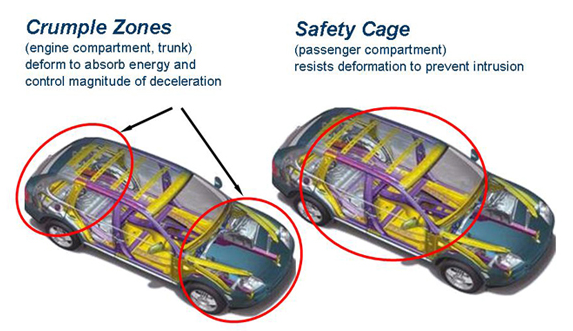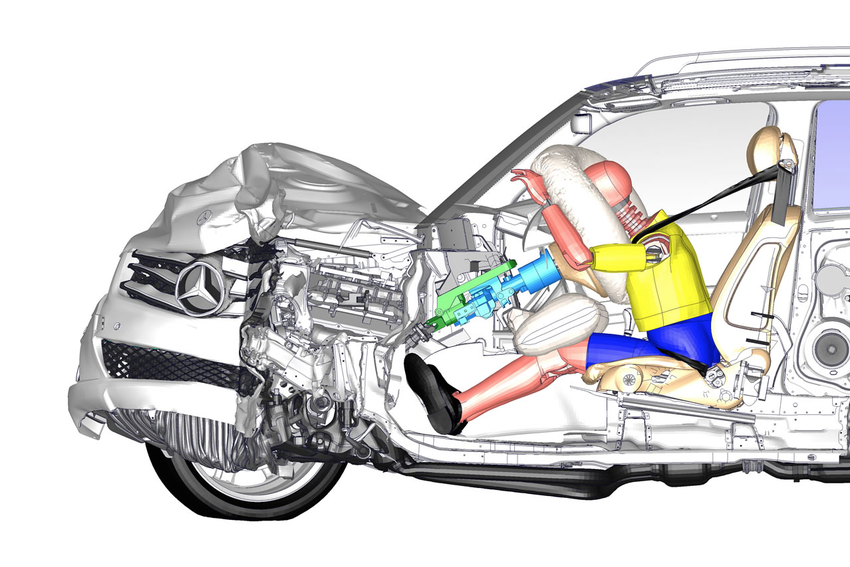The safety of your loved ones is an aspect that nobody would like to compromise on, and the increasing awareness about safer cars can only be good news. Technology and concepts to provide safer cars are not as simple as they used to be, and it has improved multiple folds in the last few decades. One such concept utilized by every single manufacturer is the crumple zones. This article explains how crumple zones work and their effectiveness in making a car safer.

The above image is a cross-section of a car’s chassis design to show the crumple zone at the front and back and a rigid high tensile steel cabin for the passenger compartment.
Subscribe To The GoMechanic YouTube Channel 🔥
What is a Crumple Zone?
Crumple zones are parts of a vehicle designed to deform and crumple in case of a collision. This absorbs some of the energy of the impact, preventing it from being transmitted to the occupants of the car. Designing a crumple zone is not an easy task since engineers have to consider multiple factors like size, weight, frame stiffness, and the stress the vehicle experiences in a crash. For example, an SUV will definitely crash with more force solely because of its weight when compared to a hatchback or a smaller car.

Crumple Zones and its Safety Goals
Crumple Zones should achieve two safety goals at the same time.

- Reduce the initial force of the crash
The most efficient way to reduce the initial force with the same amount of mass and speed is to increase the time taken for the impact to reach the passenger compartment. No, we are not asking you to consult Doctor Strange for help, and we saw how well that went for Peter Parker in “No Way Home.” This can be achieved by creating a buffer zone around the car’s perimeter. When a rigid part hits something, it decelerates very quickly, which transfers all of the force directly to the occupants, which is not a good thing. If you envelop those parts with deformable, less rigid materials in the crumple zone, they absorb the initial impact. The car begins decelerating as soon as the crumple zone starts getting deformed, and this extends the deceleration for a few tenths of a second. This delay of a few tenths of a second reduces the impact by a lot. - Redistribute the force to reduce the impact on passengers
All the force during an impact has to go somewhere, and the objective is to send it away from the passengers. Everything that happens to the car during an impact and every person inside the vehicle at the time of the impact spends some of the force. Think of how much force is needed to bend the steel frame of a car. That amount of force is spent on bending the frame, so it is never transmitted to the occupants. Crumple zones are based on that concept. Parts of the car are built with unique structures inside them that are designed to be damaged, crumpled, crushed, and broken. The fundamental idea is that it takes force to damage them. Crumple zones spend as much force as possible so that other parts of the car, as well as the occupants, don’t suffer the effects.

The Crumple Zone, along with the seatbelt and airbags, provide the highest level of protection and keep the occupants safe in case of an impact. These technologies did not start the way they are now and are still being researched to make them more effective and reduce the number of fatalities caused due to car accidents.
Absorbing and redirecting the impact is great, but it isn’t the only safety that designers have to worry about. The passenger compartment of the car has to resist being penetrated by external objects or other parts of the car, and it has to hold together, so the occupants aren’t thrown out. You can’t make an entire car a crumple zone because you don’t want the people inside it to crumble also. That’s why cars are designed with a rigid, strong frame enclosing the occupants, with crumple zones in the front and rear. Force reduction and redistribution are accomplished inside the passenger compartment through airbags.
Fuel tanks and battery packs in electric or hybrid vehicles must also be protected from impact to prevent fires. They can be designed so that a section of the frame protects the tank, but that part of the frame can bend away from the impact. For example, if a car is hit from the back, the frame bends up, lifting the gas tank out of the way and absorbing some impact. Newer cars have systems that cut off the fuel supply to the engine during a crash, and some electric cars have a fail-safe to drain all the electrical energy and shut off the battery in case of an impact.
I believe this article sheds some light on the importance of the crumple zone and its significant role in keeping the occupants safe. You can let us know which safety technology you want to know more about in the comments section below, and we will do our best to explain it as simply as possible.





